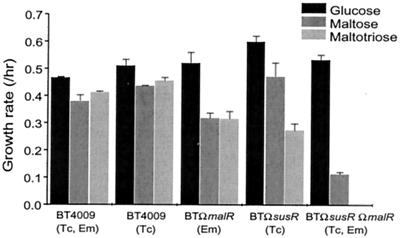FIG. 3.
Growth rates of various mutants on glucose, maltose, and maltotriose. The medium used was defined medium that contained glucose, maltose, and maltotriose, and the results are indicated by the three shaded bars in each set from left to right, respectively. The concentrations of antibiotics used in this experiment were 3 μg/ml for tetracycline (Tc) and 10 μg/ml for erythromycin (Em). These measurements were done in triplicate; the range of values is indicated by the error bars. B. thetaiotaomicron BT4009 was used as the wild-type control because it contains a single copy of tetQ and ermF. Thus, either tetracycline or erythromycin or both (Tc, Em) can be added to the medium used to grow both the control and the mutant strains. This eliminates the slight differences in growth rate that can sometimes occur due to the presence of antibiotics in the medium (note the difference between “Tc” columns versus the “Tc, Em” columns). The selectable marker used to create the BTΩmalR strain was ermF, and the marker used to create the BTΩsusR strain was tetQ. The double mutant BTΩsusRΩmalR contained both resistance genes.

